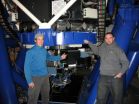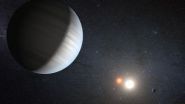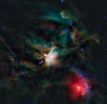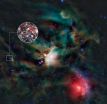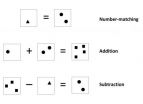(Press-News.org) Two identical FLOYDS spectrographs, installed in recent weeks at telescopes 6,000 miles apart, robotically acquired a supernovae target this week. Due to the level of precision required and the difficulty involved, few if any, other ground-based spectrographs have ever achieved this milestone.
"This is unprecedented," staff astronomer David Sand explained. "In a matter of just a few weeks, Las Cumbres Observatory was able to install the spectrographs, achieve first light, and begin robotic operations. It's unheard of." Sand is already gathering data from the spectrographs to support his research.
The FLOYDS spectrographs --- unique for their combination of design, capabilities, and level of automation --- were named after the band Pink Floyd, specifically for their album artwork on The Dark Side of the Moon, which shows a prism dispersing white light into the colors of the rainbow. Instead of sunlight, FLOYDS makes rainbows out of distant supernova explosions and gamma ray bursts to probe their chemical compositions and inner workings.
FLOYDS, installed on Faulkes Telescope North (FTN) at Haleakala Observatory and on Faulkes Telescope South (FTS) at Siding Spring Observatory, are some of the first spectrographs designed to acquire astronomical targets, observe them, and process the data without the aid of on-site astronomers. Observations that are currently rare, like studies of supernovae and gamma-ray bursts hours after their explosion, are expected to be made routine, since the telescopes can get on-target much more rapidly than they could if they were operated by people.
Robot Spectrographs
While robotic imaging telescopes are becoming increasingly common in astronomy, robotic spectrographs are rarely built for ground-based observatories. This is because the opening to a spectrograph is a narrow slit, and getting starlight to fall through the slit requires pointing the telescope to better than two-tenths of an arcsecond. This is a daunting proposition --- an arcsecond is equivalent to the width of a human hair as seen from 10 yards away.
Another unique feature of the spectrographs is their ability to observe the entire visible spectrum in a single exposure. "The FLOYDS spectrographs are sensitive to light over the entire range of visible colors," explained LCOGT Science Director, Tim Brown, "including some that cannot be seen by the human eye."
Most spectrographs require two exposures to see over such a wide range, but FLOYDS uses a clever trick to double the range it captures. Light entering the spectrograph strikes a diffraction grating, which splits the light out into a spectrum. But each diffraction angle is shared by two radiant frequencies. Most spectrographs, to achieve an unmuddied spectrum, filter out the higher or lower spectrum, leaving just half the range. FLOYDS adds a prism instead, simply offseting the location of the higher frequency spectrum to a different location on the digital camera, and capturing a much wider range of colors.
Las Cumbres Observatory Global Telescope (LCOGT) has owned and operated FTN and FTS since 2005. To date, observing on these telescopes has been limited to imaging without spectroscopic capabilities. A team from LCOGT including lead mechanical engineer Matt Dubberley, astronomer David Sand, telescope technicians Mark Elphick and Mark Willis completed the installation of the spectrographs during June and July.
Finding New Things
Sand, who worked closely on the development and testing of the spectrographs, and who managed the installations, said "FLOYDS is the next step in understanding the physics behind time varying astrophysical events. We will be able to identify supernovae earlier than ever before, perhaps gaining insight into their explosion mechanisms. FLOYDS also allows us to monitor objects for months on end, something that is very difficult to arrange with non-robotic telescopes. Coupling robotic spectrographs into our telescope network gives astronomers a huge edge."
When supernovae and gamma-ray bursts occur, astronomers may have only minutes or hours to capture the fast-evolving details, such as observing the actual supernova shock breaking out of a red giant star. Such events have been seen only a handful of times, but these observations are critical in linking the explosions to the progenitor star, which cannot otherwise be seen. Previously, shock breakouts were only seen when the astronomers got lucky. The right observer had to be at the right telescope, at the right time, when a supernova close enough was discovered early.
But robotic spectrographs like FLOYDS can be programmed to automatically observe targets from a sky survey, and interrupt other telescope observations to get them. And by having two spectrographs on opposite sides of the globe, chances are improved that one of them will be in the dark and ready to observe in the hours immediately following a supernova explosion.
"Any time you get a new capability in astronomy, you find new things," says Andy Howell, leader of the supernova group at Las Cumbres Observatory. "This is my dream spectrograph. There's a whole universe of stuff out there we've barely glimpsed because of technological limitations. Not any more!"
INFORMATION:
Las Cumbres Observatory spectrographs acquire target robotically
2012-08-29
ELSE PRESS RELEASES FROM THIS DATE:
Stanford researchers discover the 'anternet'
2012-08-29
On the surface, ants and the Internet don't seem to have much in common. But two Stanford researchers have discovered that a species of harvester ants determine how many foragers to send out of the nest in much the same way that Internet protocols discover how much bandwidth is available for the transfer of data. The researchers are calling it the "anternet."
Deborah Gordon, a biology professor at Stanford, has been studying ants for more than 20 years. When she figured out how the harvester ant colonies she had been observing in Arizona decided when to send out more ...
Kepler discovers planetary system orbiting two suns
2012-08-29
The system, known as Kepler-47, harbours the smallest known transiting circumbinary planets -- planets orbiting a pair of stars -- to date. The planets were discovered using NASA's Kepler space telescope [1] by monitoring thefaint drop in brightness produced when both planets transit (eclipse) their host stars [2].
"In contrast to a single planet orbiting a single star, planets whirling around a binary system transit a moving target," explains Jerome Orosz (San Diego State University, USA), lead author of the study. "The time intervals between the transits and their duration ...
Sweet building blocks of life found around young star
2012-08-29
Life is made up of a series of complex organic molecules, including sugars. A team of astronomers led by researchers from the Niels Bohr Institute, have now observed a simple sugar molecule in the gas surrounding a young star and this discovery proves that the building blocks of life were already present during planet formation. The results have been published in the scientific journal Astrophysical Journal Letters.
The star was observed with the new large international telescope, Atacama Large Millimeter Array (ALMA) in northern Chile. The ALMA telescopes are able to ...
Sweet result from ALMA
2012-08-29
A team of astronomers using the Atacama Large Millimeter/submillimeter Array (ALMA) has spotted sugar molecules in the gas surrounding a young Sun-like star. This is the first time sugar been found in space around such a star, and the discovery shows that the building blocks of life are in the right place, at the right time, to be included in planets forming around the star.
The astronomers found molecules of glycolaldehyde -- a simple form of sugar [1] -- in the gas surrounding a young binary star, with similar mass to the Sun, called IRAS 16293-2422. Glycolaldehyde ...
Adelaide joins with Italy to develop 'super spaghetti'
2012-08-29
University of Adelaide researchers are working with colleagues in Italy to produce better quality pasta that also adds greater value to human health.
Two research projects - being conducted by the ARC Centre of Excellence in Plant Cell Walls at the University's Waite Campus - will start next month in collaboration with researchers from the Italian universities of Bari and Molise.
The aim of the ARC Centre of Excellence is to look at the fundamental role of cell walls (biomass) in plants and discover how they can be better utilized. Both of these new projects will investigate ...
Math ability requires crosstalk in the brain
2012-08-29
A new study by researchers at UT Dallas' Center for Vital Longevity, Duke University, and the University of Michigan has found that the strength of communication between the left and right hemispheres of the brain predicts performance on basic arithmetic problems. The findings shed light on the neural basis of human math abilities and suggest a possible route to aiding those who suffer from dyscalculia-- an inability to understand and manipulate numbers.
It has been known for some time that the parietal cortex, the top/middle region of the brain, plays a central role ...
New 'traffic light' test could save lives with earlier diagnosis of liver disease
2012-08-29
A new 'traffic light' test devised by Dr Nick Sheron and colleagues at University of Southampton and Southampton General Hospital could be used in primary care to diagnose liver fibrosis and cirrhosis in high risk populations more easily than at present.
Liver disease develops silently without symptoms, and many people have no idea they have liver failure until it is too late – one-third of people admitted to hospital with end-stage liver disease die within the first few months. A simple test available in primary care could diagnose disease much earlier, enabling those ...
Internet addiction -- Causes at the molecular level
2012-08-29
"It was shown that Internet addiction is not a figment of our imagination," says the lead author, Privatdozent Dr. Christian Montag from the Department for Differential and Biological Psychology at the University of Bonn. "Researchers and therapists are increasingly closing in on it." Over the past years, the Bonn researchers have interviewed a total of 843 people about their Internet habits. An analysis of the questionnaires shows that 132 men and women in this group exhibit problematic behavior in how they handle the online medium; all their thoughts revolve around the ...
Twitter data crunching: The new crystal ball
2012-08-29
Fabio Ciulla from Northeastern University, Boston, USA, and his colleagues demonstrated that the elimination of contestants in TV talent shows based on public voting, such as American Idol, can be anticipated. They unveiled the predictive power of microblogging Twitter signals--used as a proxy for the general preference of an audience--in a study recently published in EPJ Data Science¹.
The authors considered the voting system of these shows as a basic test to assess the predictive power of Twitter signals. They relied on the overlap between Twitter users and show audience ...
Earphones 'potentially as dangerous as noise from jet engines,' according to new study
2012-08-29
Turning the volume up too high on your headphones can damage the coating of nerve cells, leading to temporary deafness; scientists from the University of Leicester have shown for the first time.
Earphones or headphones on personal music players can reach noise levels similar to those of jet engines, the researchers said.
Noises louder than 110 decibels are known to cause hearing problems such as temporary deafness and tinnitus (ringing in the ears), but the University of Leicester study is the first time the underlying cell damage has been observed.
The study has ...
